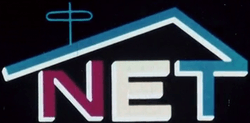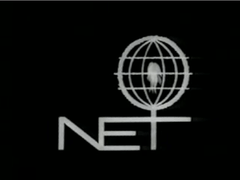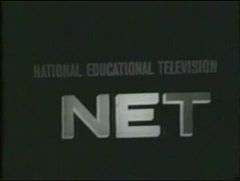National Educational Television
National Educational Television (NET) was a United States educational broadcast television network that operated from May 16, 1954 to October 4, 1970. It was owned by the Ford Foundation and later co-owned by the Corporation for Public Broadcasting. It was succeeded by a successful network under the name the Public Broadcasting Service (simply known as PBS for short), which has memberships with many television stations that were formerly part of NET.
 | |
| Country | United States |
|---|---|
| Founded | November 21, 1952 |
| Slogan | This is National Educational Television (1954–1965) This is N-E-T, National Educational Television (1960–1965, 1970) This is N-E-T, the National Educational Television Network (1963–1968) The Public Television Network (1968–1970) |
Broadcast area | United States and Canada |
| Owner | Ford Foundation (1954–1970) Corporation for Public Broadcasting (1967–1970) |
Launch date | May 16, 1954 (as a network) |
| Dissolved | October 4, 1970 |
Former names | Educational Television and Radio Center National Educational Television and Radio Center |
| Replaced by | PBS |
.jpg)
Net

The network was founded as the Educational Television and Radio Center (ETRC) in November 1952 by a grant from the Ford Foundation's Fund for Adult Education (FAE). It was originally a limited service for exchanging and distributing educational television programs produced by local television stations to other stations; it did not produce any material by itself.[1]
In the spring of 1954, ETRC moved its operations to Ann Arbor, Michigan, and on May 16 of that year, it began operating as a "network". It put together a weekly five-hour package of television programs, distributing them primarily on kinescope film to the affiliated stations by mail.[2] By 1956, ETRC had 22 affiliated stations, expected to grow to 26 by March 1957.[3] The programming was noted for treating subjects in depth, including hour-long interviews with people of literary and historical importance. The programming was also noted for being dry and academic, with little consideration given to entertainment value, a marked contrast to commercial television. Many of the shows were designed as adult education, and ETRC was nicknamed the "University of the Air"[4] (or, less kindly, "The Bicycle Network", both for its low budget and for the way NET supposedly sent programs to its affiliates, by distributing its program films and videotapes via non-electronic means such as by mail, termed in the television industry as "bicycling").
The center's headquarters moved from Ann Arbor to New York City in 1958, and the organization became known as the National Educational Television and Radio Center (NETRC).[1] The center became more aggressive at this time, aiming to ascend to the role of the U.S.' fourth television network. Among its efforts, the network began importing programs from the BBC into the United States, starting with An Age of Kings in 1961.[5] It increased its programming output to ten hours a week.[1] Most NETRC network programs were produced by the affiliate stations because the NETRC had no production staff or facilities of its own. NETRC also contracted programs from independent producers and acquired foreign material from countries like Canada, the United Kingdom, Australia, Yugoslavia, the USSR, France, Italy and West Germany.[6]
Starting from 1962, the federal government took over the FAE's grants-in-aid program through the Education Television Facilities Act.[7]
| External video | |
|---|---|
_-_NARA_cropped.jpg) | |
Eleanor Roosevelt, chair of the Presidential Commission on the Status of Women, interviews President John F. Kennedy, Secretary of Labor Arthur Goldberg and others, Open Vault from WGBH[8] |
In November 1963 NETRC changed its name to National Educational Television, and spun off its radio assets. Under the centerpiece program NET Journal, which began airing in fall of 1966, NET began to air controversial, hard-hitting documentaries that explored numerous social issues of the day such as poverty and racism. While praised by critics, some affiliates, especially those in politically and culturally conservative markets, objected to the perceived liberal slant of the programming.[9] Another NET produced program begun in 1967, Public Broadcast Laboratory, produced similar complaints.
In 1966, NET's position as a combined network and production center came into question when President Lyndon Johnson arranged for the Carnegie Foundation to conduct a study on future of educational television. The Carnegie Commission released its report in 1967, recommending educational television be transformed to "public television". The new organization would be controlled by the nonprofit Corporation for Public Broadcasting (a corporation established by the federal government) and receive funding from the government and other sources. Under this plan, funds were to be distributed to individual stations and to independent production centers – which is what NET would be reduced to under this plan. The Ford Foundation, interested Educational Television Stations, and President Johnson supported the recommendations of the Carnegie Commission in the Public Broadcasting Act, which was signed into law on November 7, 1967.[10]
Replacement by PBS

The Public Broadcasting Service (PBS) began as an entity in November 1969, with NET continuing to produce several programs and to be the name of the network. NET's production of NET Journal and Public Broadcast Laboratory continued to be liabilities amidst accusations of partisanship funded by the government. Eventually, the CPB and the Ford Foundation decided to shut NET down. In early 1970, both threatened to cut NET funding unless NET merged its operations with New York City-area affiliate WNDT. NET agreed to do so.
WNDT's call sign was changed to WNET on October 1, 1970 as the station and NET's merger was completed.[11] On October 5, PBS began network broadcasting. NET ceased to operate as a network from that point, although some NET-branded programming, such as NET Journal and NET Playhouse remained part of the PBS schedule (now produced by WNET) until the brand was retired. Some of the programs that began their runs on NET, such as Washington Week and Sesame Street, continue to air on PBS today.
See also
- PBS idents (includes IDs for NET)
- Public Broadcast Laboratory
- List of United States television networks
References
- "National Educational Television (NET)". National Public Broadcasting Archives. Archived from the original on 22 August 2012. Retrieved 5 September 2013.
- "Ford Foundation Activities in Noncommercial Broadcasting, 1951-1976". Ford Foundation. 2009. Archived from the original on 2008-12-01. Retrieved 2009-02-14.
- "Tired of Banal Television? Try Tuning in to Educational Station". Labor's Daily. 1956-12-24. p. 5. Retrieved 2020-07-20.
- Carolyn N. Brooks (29 November 2007). "National Educational Television Center (NET)". Museum of Broadcast Communications. Retrieved 2008-12-30.
- An Age of Kings: an import becomes public TV’s first hit, David Stewart, Current, December 21, 1998
- Saettler, Paul (2004). The Evolution of American Educational Technology. p. 376.
- Engelman, Ralph (1996). Public Radio and Television in America, a political history. p. 140.
- "Prospects of Mankind with Eleanor Roosevelt; What Status For Women?". National Educational Television. Open Vault at WGBH. 1962. Retrieved September 19, 2016.
- "The Museum of Broadcast Communications - Encyclopedia of Television". Museum.tv. Retrieved 2016-07-13.
- Saettler, Paul (2004). The Evolution of American Educational Technology. p. 378.
- "News Around the Dial". Daily News. 1970-10-01. p. 234. Retrieved 2020-07-20.
External links
- National Education Television Center on The Museum of Broadcast Communications
- Carolyn N. Brooks (29 November 2007). "National Educational Television Center (NET)". Museum of Broadcast Communications. Retrieved 2008-12-30.
- Frederick M. Remley papers and Nazaret Cherkezian papers, at the University of Maryland libraries. Remley worked on the Video Tape Engineering Committee focusing on standards for video tape recordings, and Cherkezian served as executive producer for NET's News in Perspective, a co-production with The New York Times, from 1963 to 1970.